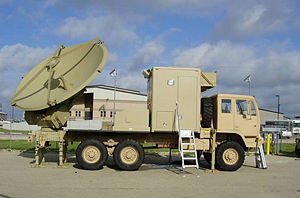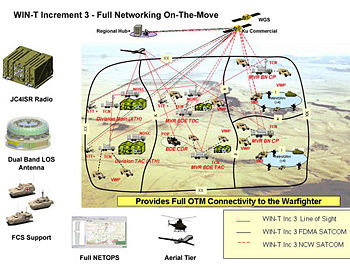Warfighter Information Network–Tactical: Difference between revisions
imported>Howard C. Berkowitz |
imported>Howard C. Berkowitz |
||
| Line 7: | Line 7: | ||
Eventually, all equipment in WIN-T will be mobile, defined as usable while "on the move" (OTM). The initial increment has equipment that is transportable but has to stop to be operational. | Eventually, all equipment in WIN-T will be mobile, defined as usable while "on the move" (OTM). The initial increment has equipment that is transportable but has to stop to be operational. | ||
==Increment | ==Increment one== | ||
The initial Increment 1 will include transportable components, moved among field locations by vehicles or aircraft normally available to the Army). This does not mean that individual soldier or vehicles will have to stop to communicate, but that the individual equipment will have to have some transportable infrastructure in range. There are three levels of transportable equipment in this increment:<ref>{{citation | The initial Increment 1 will include transportable components, moved among field locations by vehicles or aircraft normally available to the Army). This does not mean that individual soldier or vehicles will have to stop to communicate, but that the individual equipment will have to have some transportable infrastructure in range. There are three levels of transportable equipment in this increment:<ref>{{citation | ||
| url = http://peoc3t.monmouth.army.mil/win_t/increment_1.html | | url = http://peoc3t.monmouth.army.mil/win_t/increment_1.html | ||
Revision as of 21:11, 30 January 2009
Template:TOC-right Warfighter Information Network-Tactical (WIN-T) is the evolving United States Army tactical communications network system. An earlier concept was called the Joint Network Node Network (JNN-N). It forms the Army’s tactical portion of the Global Information Grid (GIG) network, via the Army Battle Command System. WIN-T equipment may make use of commercial or military communications satellites, or tie into other commercial networks, especially if connecting to the GIG, but will always retain an independent radio-based tactical transmission capability. From a technology standpoint, it will replace existing connectivity equipment such as the general-purpose Mobile Subscriber Equipment (MSE), as well as dedicated networks for intelligence and logistics. [1] MSE and the AN/TTC-39 switch were part of an earlier tactical architecture, of less ambitious scope, called TRI-TAC. Some individual pieces of equipment, such as the AN-TTC-56 switch, are transitional between TRI-TAC and full WIN-T.
Eventually, all equipment in WIN-T will be mobile, defined as usable while "on the move" (OTM). The initial increment has equipment that is transportable but has to stop to be operational.
Increment one
The initial Increment 1 will include transportable components, moved among field locations by vehicles or aircraft normally available to the Army). This does not mean that individual soldier or vehicles will have to stop to communicate, but that the individual equipment will have to have some transportable infrastructure in range. There are three levels of transportable equipment in this increment:[2]
- Unit (or Division) Hub, carried by Family of Medium Tactical Vehicles (FMTV) trucks
- the Brigade (or JNN) Hub, in a shelter that is carried by a HMMWV
- Battalion Command Post Node, transported by vehicle but mounted and placed in the command post in transit cases.
All three types have a satellite terminal. Terrestrial line-of-sight communications between shelters in Increment One is provided by the AN/GRC-245 Enhanced High Capacity Line-of-Sight (HCLOS) radio. According to WIN-T program manager COL William Hoppe, WIN-T Increments Two and Three will bring the initial and full on-the-move capability, where stopping is not required for communications.
Your cell phone is a mobile device, but as soon as you leave the coverage area of your cell phone tower, you drop your signal. That’s Increment One, where you have communications at the halt within a footprint. In Increment Two, we’re going to take that cell tower equivalent infrastructure and we’re going to move it along with the mobile device, so you have communications every place you have your infrastructure.[3]
Increment Two
The type of technology required for the Increment Two capability is, in general communications engineering, called self-organizing or ad hoc networking. Increment One makes considerable use of commercial communications satellites. Increment Two, however, while using commercial capability as an adjunct, will make much more extensive use of military satellites such the Wideband Global Satellite communications system, which had its first operational launch in October 2007. These satellites have approximately 10 times the bandwidth of their DSCS III (Defense Satellite Communications System) predecessors; the WGS can route between 2.1 and 3.6 Gbps of digital information. [4]
Increment Two is also specifically oriented to the Brigade Combat Team concept in the restructuring of the United States Army. [5] It provides the initial OTM capability. :[6] It uses Highband Network Radios for line of sight, and also interfaces to the vehicle- and unit-level SINCGARS radio. SINCGARS equipment radios will be replaced by waveform-compatible equipment of the Joint Tactical Radio System.
Increment Two also makes use of a technology, similar to used in commercial satellite telephones such as the Thuraya system operating in the Middle East and Africa since 2000, which tie into cellular telephony networks when available, but go to a satellite when no appropriate terrestrial capability is present.[7]
Field tests were conducted in 2007, and this increment is expected to begin deploying in 2010.[5]
Increment Three
In Increment Three, unmanned aerial vehicle communications relays, as in the MQ-8, will supplement the satellites. These allow operations when insufficient satellite capability is in orbit, or when ground operations are on a part of the earth that is not well covered by satellites (e.g., polar regions), or if an adversary could interfere with or destroy satellites. It also supports new-generation Future Combat Systems.
The contract was awarded in 2007, and deployments may begin in 2011.[8]
Increment Four
Increment Four makes the air and satellite communications relays even more robust against electronic warfare. Hoppe described this as "That’s where we’re taking advantage of the secure anti-jam, low probability detection satellite communications off of things like the Transformation Satellite Communications system into our radio systems".[3]
The space segment of Increment Four will make use of the five-satellite Transformational Satellite System (TSAT) constellation using laser rather than radio links earth, but radio among the satellites. Launches are planned to begin in 2013, [9] although the project is still in a government-funded competitive proposal stage and operational funds have not been committed. This will have extremely high bandwidth, in the hundreds of gigabits.
References
- ↑ U.S. Army 2008 Posture Statement, Warfighter Information Network-Tactical
- ↑ Project Manager Warfighter Information Network - Tactical, Increment 1
- ↑ 3.0 3.1 Joshua Davidson (April 2008), "WIN-T Expands the Army’s Communications Pipes for Increased Applications", U.S. Army Acquisition Support Center
- ↑ Boeing Integrated Defense Systems, Transformational Wideband Communication Capabilities for the Warfighter: WGS Mission
- ↑ 5.0 5.1 "WIN-T Increment 2", Globalsecurity
- ↑ Project Manager Warfighter Information Network - Tactical, Increment 2
- ↑ Thuraya satellite
- ↑ "WIN-T Increment 3", Globalsecurity
- ↑ "Transformational SATCOM (TSAT), Transformational Communications Satellite (TSAT), Advanced Wideband System", Globalsecurity
- CZ Live
- Military Workgroup
- Engineering Workgroup
- Internet operations Subgroup
- Military information and communications Subgroup
- Articles written in American English
- Advanced Articles written in American English
- All Content
- Military Content
- Engineering Content
- Military tag
- Internet operations tag
- Military information and communications tag


